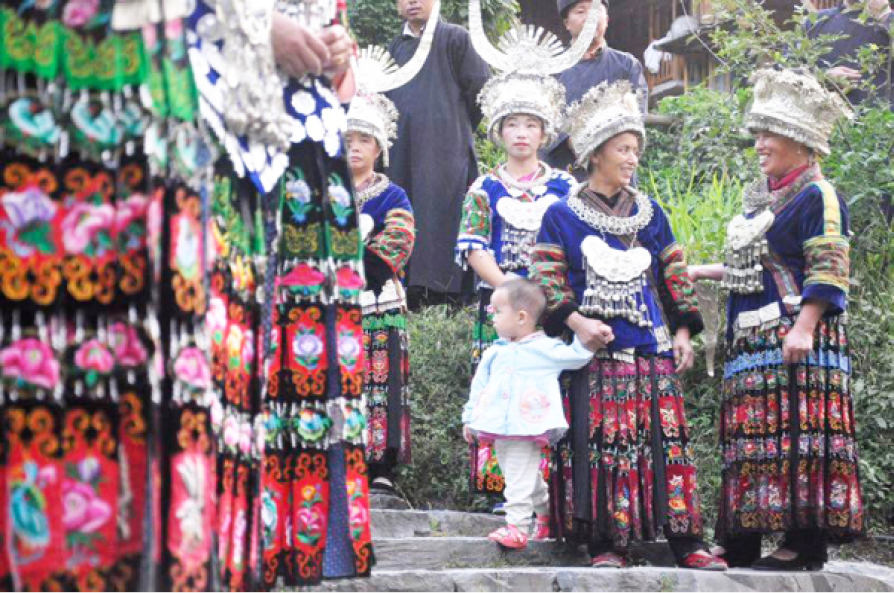Thrilling dance and dine of China’s Miao people
The Miao ethnic group in China are gifted weavers of artworks, leather and embroidery materials. But nothing compares to how they weave their way into the hearts of guests with their dance and feast. The rhythmic movement of the dancers holding hands together can make the mind merry and fonder. When the delegation of African […]

Miao villagers get set for their dance performance
The Miao ethnic group in China are gifted weavers of artworks, leather and embroidery materials. But nothing compares to how they weave their way into the hearts of guests with their dance and feast.
The rhythmic movement of the dancers holding hands together can make the mind merry and fonder.
When the delegation of African journalists, who are part of the Belt and Road News Network (BRNN) workshop, visited the Miao villages in the South East of Ghuizou Province, both the very old and the young turned up in beautiful costumes with smiling faces. The men blew the flutes, and the women beat the tidlos and timbrels in their traditional dance steps.
The Miaos live in Guizhou, Yunnan, Sichuan, Hubei, Hunan, Guangxi, Guangdong and Hainan provinces all in China’s South with a population of 8,940,116.
A woman, who identified herself as Ahua from Dong village said the community adorns their unique costume during big occasions such as receiving foreign visitors, weddings and others.
She and other villagers have seen many of such celebrations, especially, the 2008 Olympics in Beijing when the magnificent, ancient Chinese-inspired “Lucky Cloud” Olympic relay torch touched down on their soil.
One of the guides told the visitors that Miao’s ancestry can be traced back to the ‘Chiyou’ tribe, a tribe in the primitive society in the Central Plains. During the Shang and Zhou dynasties, the Miao’s ancestors began to construct their kingdom in the lower reaches of the Yangtze River. Later, they gradually migrated to the southern part of China, where they now reside.
The Miaos used to practice traditional religions. Now, they have other faiths such as Christianity especially, the Catholic Church.
The Miaos inhabit the hilly and mountainous areas in Guizhou drained by several big rivers. Due to a mild climate and sufficient rainfall, they grow wheat, paddy rice, maize, potatoes, Chinese sorghum, beans, rape, peanuts, tobacco, ramie, sugar cane, cotton, oil-tea camellia and tung tree.

The African journalists, who participated in a Miao cultural ceremony during the trip to villages in Qiandongnan Miao and Dong Autonomous Prefecture, Southwest China’s Guizhou Province also got to learn that Guizhou Province is not all about dances and local wines. The region has become a symbol of poverty alleviation in Asia.
“Development in ethnic regions is an important link in the province’s goal of achieving synchronous prosperity, which deserves special efforts,” Xu Fei, an official with the Ethnic and Religious Affairs Commission of Guizhou Province said.
As China continues to roll out programmes in support of ethnic minority groups, Guizhou has taken the lead. It has developed differentiated poverty alleviation policies in ethnic regions aimed at incentivizing and reinforcing their self-development abilities.
It has also designed regulations for implementing ethnic regional autonomy law, promoting ethnic solidarity and progress and regulations on ethnic township protection and development. These regulations guarantee financial support to ethnic regions.
“These preferential policies that target the difficulties and problems in the development of ethnic groups provide specific support policies to all autonomous prefectures, counties and towns, establishing a complete policy framework for poverty alleviation work in ethnic regions,” Xu said.
Perhaps with the high-speed rail line currently being built to connect Miao’s villages to Guiyang city, the capital of Guizhou Province, the people may be exporting their dance and wine to other parts of the world.
